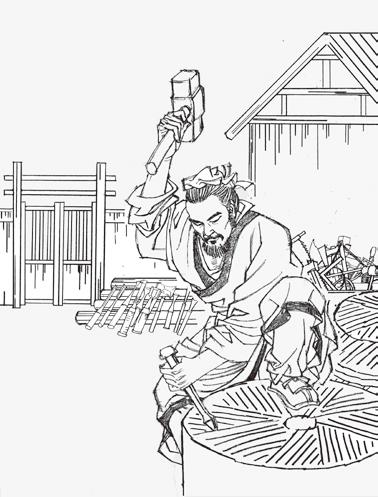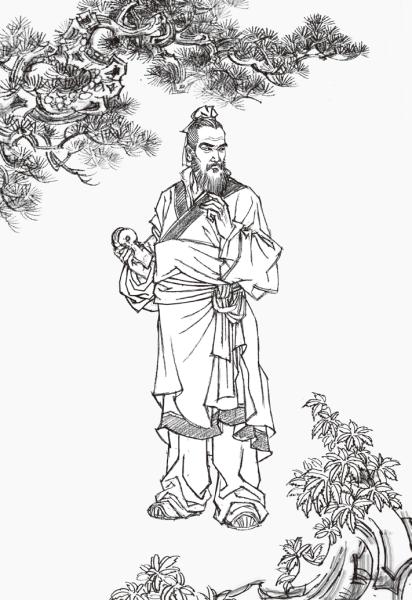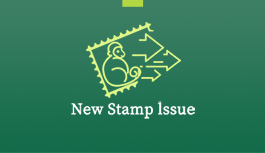Postal Business: 8610 11185
Postal Savings: 8610 95580
Logistics and EMS: 8610 11183
China Post Life: 8610 4008909999
Lu Ban is a household name known to everyone in China. On August 24, China Post issued a set of 2 special stamps and a miniature sheet with the theme of Lu Ban. Before the issuance, Meng Fancong, the designer of the stamps, famous youth painter and graphic designer, dwelt on his ideas and feelings about the design to the media.
The 2 special stamps are “diligent learning” and “careful study”, depicting respectively the young Lu Ban learning his skills assiduously and the middle-aged Lu Ban inventing the stone mill by carving a large stone. The miniature sheet is the portrait of Lu Ban, showing the old-aged Lu Ban in deep contemplation. This set of stamps is designed by Meng Fancong with traditional meticulous techniques.
Lu Ban lived in the late Spring and Autumn Period and the early Warring States Period over 2400 years ago. As a prolific inventor, he is honored as the originator of architecture, father of the carpenters as well as founder of theatrical troupes and so on. Previously, Meng Fancong had designed two sets of special stamps Yue Fei, the famous general in ancient China and National Heroes in Modern Chinese History, the 6 historical figures in which are much later in history than Lu Ban. Lu Ban is even the “oldest” historical figure ever appearing on Chinese stamps since the series of special stamps of ancient outstanding sages were issued, as he is earlier in history than Guan Yu, Zhuge Liang, Bao Zheng, Buddhist monk Xuanzang, Zhang Qian and Qu Yuan.
On March 5, Meng Fancong and Li Kexin, the editor in charge, visited Lu Ban’s hometown in Tengzhou city, Shandong province and Lu Ban Memorial at the town of Jiehe. They explored the culture associated with Lu Ban, collected materials for art creation, and improved their perceptual knowledge during the visit.
After he studied the materials at hand, pondered on Lu Ban’s inventions, and combined with his own experience during the field trip to Lu Ban’s hometown, Meng Fancong holds that the identity of Lu Ban was not simply a handy man. From what Lu Ban had invented, Meng Fancong found that, obviously different from the ordinary handy men and their rather simple labor work, Lu Ban had involved his thoughts into his inventions. Therefore, He was able to invent aerial ladders for warfare and such weapons as “Gou” (a long hook) and “Ju” (a kind of weapon for defense) for the navy of the state of Chu, which were far beyond the reach of any ordinary people at that time.
In the specific process of the stamp design, Meng Fancong focused his attention on 2 principles. On the one hand, Lu Ban was a master craftsman, not just a handy man engaging in simple manual labor. On the other hand, Lu Ban was not a literati either. During the design of the stamps, Meng Fancong strived to depict the image of Lu Ban as an integration of craftsman and sage who engaged not only in manual but also in mental work. It should be said that Meng has grasped the core characteristics of the figure.
On the miniature sheet is a full-body image of the old-aged Lu Ban, deep in thought, holding a carpenter’s ink marker in one hand and twisting his beard in the other. He looks straight and sound, his hair simply wrapped in a headscarf, his cheeks thin, eyebrows bushy and eyes shrewd, with his moustache and beard dense on his lips and chin. In the design, Lu Ban’s forehead is high with deep-cut wrinkles, showing his wisdom and intelligence, also indicating his experiences of vicissitudes. As Lu Ban assumed no official position, he was dressed in short robes. On the upper left-hand of the background are vigorous pine branches, while on the lower right are some lush greenery and rocks, implying that Lu Ban’ inventions will last forever and benefit all generations.
The edging design of the special mini-pane Lu Ban is also the work of Meng Fancong. Based on the pictures taken during his field trip, he drew the Lu Ban dike, and added to it decorative water waves in line drawing in traditional ink and brush style.
 |
 |
 |
Sketches of special stamps and miniature sheet Lu Ban






